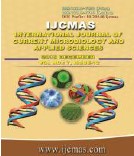


 National Academy of Agricultural Sciences (NAAS)
National Academy of Agricultural Sciences (NAAS)

|
PRINT ISSN : 2319-7692
Online ISSN : 2319-7706 Issues : 12 per year Publisher : Excellent Publishers Email : editorijcmas@gmail.com / submit@ijcmas.com Editor-in-chief: Dr.M.Prakash Index Copernicus ICV 2018: 95.39 NAAS RATING 2020: 5.38 |
Nanotechnology is an interdisciplinary having significant role in modern science. Myconanotechnology is an emerging field, where fungi are being used for the synthesis of nanoparticles with desirable size and shape. Fungi have an added advantage over bacteria as well as actinomycetes, as fungi are excellent secretors of proteins leads to a higher yield of nanoparticles which are highly stable, cost-effective, eco-friendly and non-toxic. Currently, a wide range of potential fungi are being screened to create different nanoparticles, such as silver, selenium, platinum, gold, silica, zirconium, zinc oxide, copper, titanium, chitosan, and magnetite had also been reported by various researchers. Mycogenic nanoparticles in phytopathogen management are still in early stage of research. Nowadays due to climate change, farming communities are facing major challenges such as emergence of new diseases and pest, nutrient deficiency, thereby reducing the crop yield. Nearly 2.5 metric tons of chemical pesticides are used annually for the management of various diseases and pests, these chemicals are toxic for both soil and aerial environment. Moreover, mycogenic nanoparticles are non-toxic, possess excellent antimicrobial properties, and have a wide range of applications for plant disease and pest management, enhanced nutrient uptake and improved plant growth. Different experiments have revealed that fungal hyphae and conidial germination of pathogenic fungi are inhibited by mycogenic silver selenium and copper nanoparticles. These myconanoparticles can be used for accurate disease diagnosis and also for its eco-friendly management. The progress towards the development of nano-herbicides, nano-fungicides and nano-pesticides will open-up new avenues in the field of integrated crop management. However some challenges particularly toxicity, which is not a big issues as compare to chemical fungicides and pesticides are hindering the commercialization of myconanoparticles in plant disease management.
 |
 |
 |
 |
 |